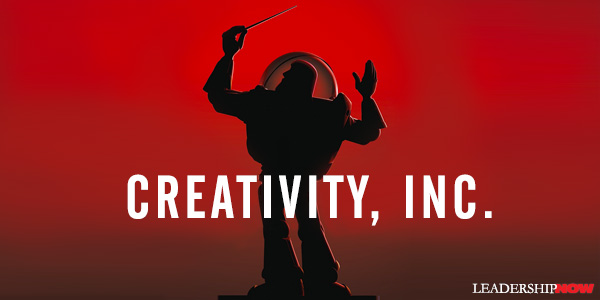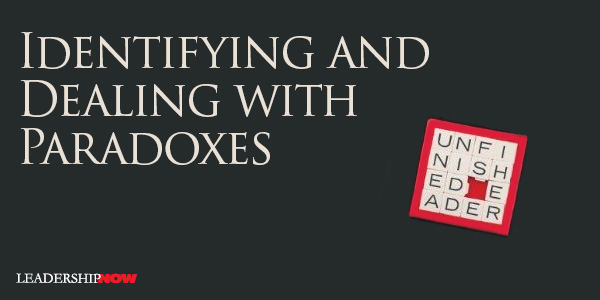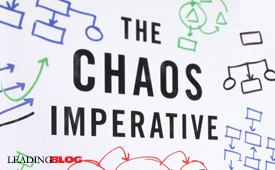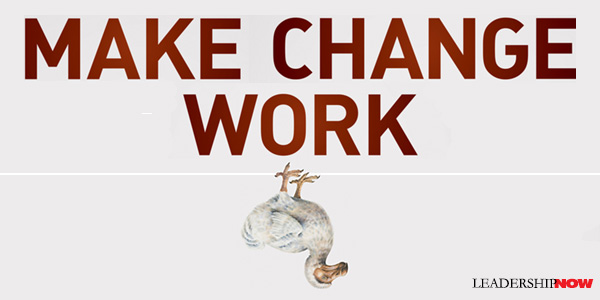 Leading Blog | Posts by Month |
 Leading Blog | Posts by Month |
05.31.14

LeadershipNow 140: May 2014 Compilation
See more on
Posted by Michael McKinney at 09:59 PM
05.23.14

Creativity, Inc.
Ed Catmull’s Book, Creativity, Inc. is about how to lead when you care about and believe in the people you lead. Catmull is co-founder of Pixar Animation Studios and president of Pixar Animation and Disney Animation. Rethink, adapt, and push-on describes his career path. Inspire by the TV show, The Wonderful World of Disney, Catmull wanted to be an animator. But he knew he would never be good enough to do it professionally. So, naturally, he went into physics and the emerging field of computer science. Eventually, that lead him to computer graphics. By 26 he had set a life goal: To make the first computer-animated feature film. By pursuing what he was good at it allowed him to do what he was passionate about. A good section for any young person to read who is wondering "What next?"From the early days at Lucasfilm to Pixar, success caused Catmull to ask why companies expanded like bubbles and then burst. “What was causing smart people to make decisions that sent their companies off the rails? Can paying careful attention to the missteps of others help us to be more alert to our own? Or is there something about becoming a leader that makes you blind to the things that threaten the well-being of your enterprise?” Creativity, Inc. provides insight into the answers to these questions from his experience at Pixar. It’s “about the ongoing work of paying attention—of leading by being self-aware, as managers and as companies.” After the success of Toy Story, he discovered an important dynamic: The good stuff was hiding the bad stuff. “When downsides coexist with upsides, as they often do, people are reluctant to explore what’s bugging them, for fear of being labeled complainers. I also realized that this kind of thing, if left unaddressed, could fester and destroy Pixar. Being on the lookout for problems was not the same as seeing problems.” Another key lesson : “Getting the team right is the necessary precursor to getting the ideas right. That means it is better to focus on how a team is performing, not on the talents of the individuals within it. Find, develop, and support good people, and they will in turn find, develop, and own good ideas.” Catmull admits, “early on all of our movies suck.” He walks us through the process they use to develop ideas into a successful finished product. Candor is key. At Pixar, candor trumps hierarchy. “People who take on complicated creative projects become lost at some point in the process. The details converge to obscure the whole, and that makes it difficult to move forward substantially in any one direction. The experience can be overwhelming. No matter what, the process of coming to clarity takes patience and candor.” At Pixar they have built candor into the system by the use of various feedback mechanisms. For example they have the Braintrust. It is made up of people with a deep understanding of storytelling and, usually, people who have been through the process themselves. It has no authority and it doesn’t try to fix the problem but to try to identify the root cause of the problem. The inevitability of mistakes is a given. They are the consequence of doing something new. “Failure is a manifestation of learning and exploration.” Importantly, “if your primary goal is to have a fully worked out, set-in-stone plan, you are only upping your chances of being unoriginal.” Start things that might fail. “Management’s job is not to prevent risk but to build the ability to recover.” Along with that is the leader’s responsibility to protect the new. “Part of our job is to protect the new from people who don’t understand that in order for greatness to emerge, there must be phases of not-so-greatness.” A new idea “may be ungainly and poorly defined, but it is also the opposite of established and entrenched—and that is precisely what is exciting about it.” Incidentally, it is the insecurity of leaders that causes them to take issue with the uncertainty of the new. Instead of growing they mobilize all of their strength in defense of the status quo. Sometimes there is no other way to grow than “by putting yourself in the unstable place and then feeling your way.” A leader that won’t listen or consider new ideas isn’t leading, they’re entrenching. A case for developing leaders at all levels is found in this statement: “If we allow more people to solve problems without permission, and if we tolerate (and don’t vilify) their mistakes, then we enable a much larger set of problems to be addressed.” As leaders, much of what we need to know we can’t see. A leader’s view is obstructed by “people who are skilled at figuring out what the leader wants.” We want to believe what they say. We also like to think that we are right and know more than we really do. “There is nothing quite as effective, when it comes to shutting down alternative viewpoints, as being convinced you are right.” Catmull reminds us that things constantly change as they should and “with change comes the need for adaptation, for fresh thinking, and, sometimes, for even a total reboot—of your project, your department, your division, or your company as a whole.” There will always be mistakes and problems. “We must work to uncover them and assess our own role in them” and then do whatever it takes to solve them.

Posted by Michael McKinney at 08:53 AM
05.14.14

Finishing Well
SPORTSWOMAN, polar explorer and author of On the Edge, Alison Levine, recently told Forbes about finishing well: Most of the deaths on Everest occur on the descent—after a climber reaches the top. The reason so many accidents happen on the descent is because people use everything they have—all of their energy reserves—to get to the top, and then they have nothing left in them to get themselves back down the mountain. Every year there are mountaineers who collapse just below the summit; many of them die there. Getting to the top is optional. Getting down is mandatory. You have to know yourself well enough to judge when it is time to turn around and head back down. And you need to make that call when you still have enough energy left to descend. The hard part is that quite often that turn around point is before you reach the summit. The number one goal of any expedition: come back alive. Number two is come back with all of your fingers and toes. Tagging the top of a mountain should never be the goal. The goal isn’t getting to the top. The goal is getting back down—finishing well. Many leaders struggle with finishing well. Ironically, success plants the seeds for derailment. Success encourages complacency and arrogance both of which erode character and obstruct growth. Finishing well requires a lifelong commitment to self-awareness and growth. And that means feedback. Any leader that struggles with openness to feedback is flirting with disaster. Finishing well is not an event. It is a process. It doesn’t just happen. It is a discipline—a road that the self-aware leader embarks on. Leaders who finish well develop these characteristics as part of their leadership style:
Posted by Michael McKinney at 04:58 PM
05.13.14

Leadership Impact: Where it Comes FromWhy do some leaders make an impact, while others flounder after initial success?Tim Irwin says “leadership failures rarely reflect a problem with the leader’s competence. Most often the fall occurs because of a breach of something inside the leader.” This is not surprising because we lead from our core. No matter how polished we become on the outside, eventually what is on the inside comes through. Great leadership is not a technique. It comes from within. In Impact, Irwin says, “Truly engaging others flows from the essence of who we are—from our core. Management is positional; leadership is personal.” We see this too often: “Unregulated power is one of the chief instigators of a compromised core.” Something happened along the way. Successful leadership depends on growing and protecting our core. Of course, self-awareness is key. And we must acknowledge that all is not well. “Our culture’s obsession with striving to look perfect makes us reluctant to look at our own duality—that some of our impulses are noble, while others are not so benevolent. It is not that we have yielded to our shadow, but we prefer to deny that we even have a shadow.” Power and our tendency to misuse it, is an area we need to be aware of. “Self-awareness and self regulation must grow in direct proportion to the power we exert.” Irwin discusses identifying and dealing with arrogance, the beliefs that drive our behavior, self-deception. He also stresses the need for accountability We can’t regulate our core alone. Unfortunately, too many leaders derail themselves because they think that they are too good to be held accountable by anyone else. We need to have people around us that will speak candidly with us. Accountability must be part of the organization’s culture. If it is not, the first place to look for a lack of accountability is at the very top. Steve Reinemund, former chairman and CEO of PepsiCo told Irwin: Accountability is being responsible to some other person or organization for the activities and actions we take. it is critical to an individuals performance and an organization’s integrity and credibility.They stay at their own peril too. Irwin’s book is a book to keep handy and to refer to throughout the seasons of your leadership. It will help you to stay on track and lead from a solid and uncompromised core. 
Posted by Michael McKinney at 08:11 PM
05.05.14

Identifying and Dealing with Paradoxes
THERE ARE PROBLEMS and there are paradoxes. The trouble is when we treat paradoxes as problems because then our decision-making process becomes paralyzed, inflexible, incomplete, isolated and closed. Paradoxes are recurring issues that are familiar and present throughout organizations today: the conflicting needs of purpose and profit, short- and long-term goals, local versus global demands, and the need for a flatter, more nimble organization that still executes with discipline. Paradoxes deal with uncertainty and ambiguity. They take us away from the familiar, the control, consistency, and closure we seek. If you crave control you won’t handle paradoxes well. Authors David Dotlich, Peter Cairo and Cade Cowan make an important statement in The Unfinished Leader: “The only way to become a finished leader is to remain an unfinished one.” That is to say, a leader open to possibility. “Leading through complexity requires giving up the illusion of control, consistency, and closure, while embracing the reality of being permanently unfinished.” Their research has shown that only about a third of leaders recognize paradoxes and handle them differently than they do problems, another third know they need to, and another third fail to see paradoxes at all. The Unfinished Leader offers ways in which you can learn to think differently about paradoxes and then provide tools for resolving paradoxical problems. Key to resolving a paradox is collaboration and that means letting go of control—sharing control for solving the paradox. It means letting a purpose and not a plan guide your way. “Embracing best practices from others, admitting to not having the solution, and absorbing the variety of the world prepare you to identify paradoxes and select right actions.” I’ll leave you with three thoughts from The Unfinished Leader: Too often, people do not adequately develop the interpersonal skills for collaboration, do not get beyond the thirst for control, consistency, and closure, do not work to mitigate their personal derailers, and do not overcome the human reluctance to act in the face of ambiguous, paradoxical problems.If we had leaders that would declare they have to collaborate more intensively to find actions that ameliorate things now and demand a fresh look later, we would have leaders we all could call role models: Leaders who demanded problem-solving control, yes, but yielded to paradox-solving delegation. Who demanded consistency of values and purpose, but embraced flexibility in thought and action. Who demanded closure for tame problems, called for ongoing management of society’s most wicked ills. These kinds of leaders would indeed include disciples of analysis, decision making, and execution. But they would also include masters of inquiry, collaboration, and action in the face of ambiguity.   
Posted by Michael McKinney at 08:04 PM
05.02.14

Make Change Work
“People want to be led through change, not managed through it,” says Randy Pennington. Processes are an important left-brain activity, but people want to be led into the unknown which is a right-brain and often messy activity. Change leadership is a decidedly right-brained activity. When it comes to people, the shortest distance between two points isn’t necessarily a straight line. It is often a stroll or two around the block. And that takes real leadership. Make Change Work by Randy Pennington is a change handbook informed by a good grasp of human nature. In other words, it is extremely helpful in implementing change in the real world with real people.Pennington presents the well-reasoned, tactical side of change while incorporating the emotional—“it depends”—side of change leadership. It’s the human side that Pennington weaves in so well – and so clearly – that makes the tactics work. His approach helps you to understand what you are doing “big-picture” when trying to implement any change personally or organizationally. In that regard it is an invaluable book for anyone at any level. Pennington deals with six fundamental principles that make it difficult for people and organizations to change:
Pennington writes, "There is an adage that past performance is the best predictor of future performance. That happens because most of us are not very good at thinking clearly about the opportunities presented by change."
On the other hand, coyotes are known as:
The dodo bird is extinct because it was perfectly suited to thrive in a world that ceased to exist when humans entered the picture. Coyotes, on the other hand, have flourished in a world where there are constant threats to its very survival because they continually adapt. Which one are you? Leaders who can make change work will be in constant demand. Make Change Work is about how to lead change, not manage it. Excellent material. 
 
Posted by Michael McKinney at 06:30 PM
05.01.14

First Look: Leadership Books for May 2014Here's a look at some of the best leadership books to be released in May.




For bulk orders call 1-800-423-8273  Build your leadership library with these specials on over 118 titles. All titles are at least 40% off the list price and are available only in limited quantities. “A room without books is like a body without a soul.” — Cicero
Posted by Michael McKinney at 12:17 PM
|
BUILD YOUR KNOWLEDGE


How to Do Your Start-Up Right STRAIGHT TALK FOR START-UPS 
Grow Your Leadership Skills NEW AND UPCOMING LEADERSHIP BOOKS 
Leadership Minute BITE-SIZE CONCEPTS YOU CAN CHEW ON 
Classic Leadership Books BOOKS TO READ BEFORE YOU LEAD |
|